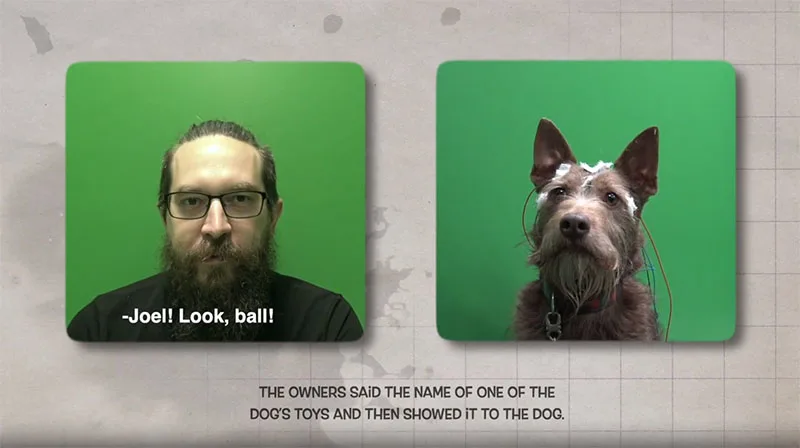“Your dog understands more than he or she shows signs of,” researchers find
March 28, 2024
By Kendall Morgan, PhD

Researchers measured brain activity of dogs using non-invasive EEG with the owners taking part in the experiment. (Photo by Oszkár-Dániel-Gáti)
Dogs understand that some words “stand for” objects, researchers discover. Watch a video and read their study in Current Biology.
It’s no surprise that your dog can learn to sit when you say “sit” and come when called. But a study appearing March 22 in the journal Current Biology has made the unexpected discovery that dogs generally also know that certain words “stand for” certain objects. When dogs hear those words, brain activity recordings suggest they activate a matching mental representation in their minds.
“Dogs do not only react with a learned behavior to certain words,” says co-first author Marianna Boros (@FamDogProject), Junior Research Fellow in the Department of Ethology at the Eötvös Loránd University in Budapest, Hungary. “They also don’t just associate that word with an object based on temporal contiguity without really understanding the meaning of those words, but they activate a memory of an object when they hear its name.”
Dogs ... activate a memory of an object when they hear its name.
Marianna Boros
Junior Research Fellow, Department of Ethology at Eötvös Loránd University
Methods
Word understanding tests with individuals who do not speak, such as infants and animals, usually require active choice, the researchers say. They’re asked to show or get an object after hearing its name. Very few dogs do well on such tests in the lab, often fetching objects correctly at a rate expected by chance.
The researchers wanted to look closer at dogs’ implicit understanding of object words by measuring brain activity using non-invasive EEG without asking them to act. The idea was that this might offer a more sensitive measure of their understanding of language.
In their studies, they had 18 dog owners say words for toys their dogs knew and then present the objects to them. Sometimes they presented the matching toy, while other times they would present an object that didn’t match. For example, an owner would say, “Zara, look, the ball,” and present the object while the dog’s brain activity was captured on EEG.
Video abstract

Watch now
|
Video abstract
Findings
The brain recording results showed a different pattern in the brain when the dogs were shown a matching object versus a mismatched one. That’s similar to what researchers have seen in humans and is widely accepted as evidence that they understand the words. The researchers also found a greater difference in those patterns for words that dogs knew better, offering further support for their understanding of object words. Interestingly, while the researchers thought this ability might depend on having a large vocabulary of object words, their findings showed that it doesn’t.
“Because typical dogs learn instruction words rather than object names, and there are only a handful of dogs with a large vocabulary of object words, we expected that dogs’ capacity for referential understanding of object words will be linked to the number of object words they know; but it wasn’t,” says Dr Lilla Magyari, also of Eötvös Loránd University and the University of Stavanger and the other co-first author.
“It doesn’t matter how many object words a dog understands — known words activate mental representations anyway, suggesting that this ability is generally present in dogs and not just in some exceptional individuals who know the names of many objects,” Boros added.
The discovery that dogs as a species may generally have a capacity to understand words in a referential way, just as humans do, might reshape the way scientists think about the uniqueness of how humans use and understand language, the researchers say. That has important implications for theories and models of language evolution. For dog owners, it’s also an important realization.
“Your dog understands more than he or she shows signs of,” Dr Magyari says. “Dogs are not merely learning a specific behavior to certain words, but they might actually understand the meaning of some individual words as humans do.”
Your dog understands more than he or she shows signs of. Dogs are not merely learning a specific behavior to certain words, but they might actually understand the meaning of some individual words as humans do.
Lilla Magyari, PhD
Associate Professor, Department of Social Studies at University of Stavanger
What’s next?
The researchers are now curious to know if this ability to understand referential language is specific to dogs or might be present in other mammals as well. Either way, they want to learn more about how this ability emerged and whether it depends on dogs’ unique experience of living with people. They also want to know why, if dogs understand object words, more of them don’t show it.
Read the study
Boros and Magyari et al., Neural evidence for referential understanding of object words in dogs, Current Biology (March 2024)
Contributor
